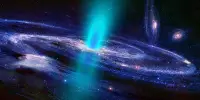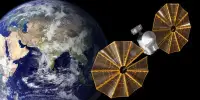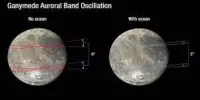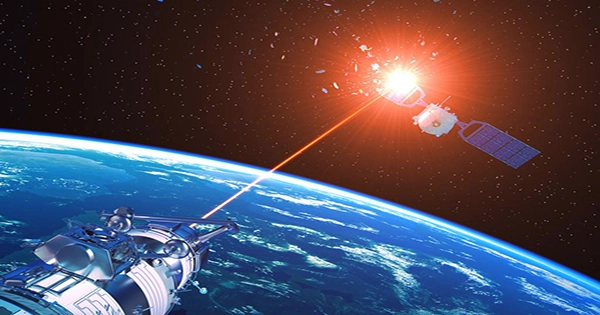Gamma-ray bursts (GRBs) are brief bursts of the most energetic form of light, gamma-ray light. GRBs, which can last from a few milliseconds to several minutes, shine hundreds of times brighter than a typical supernova and a million trillion times brighter than the Sun. When a GRB erupts, it becomes the brightest source of cosmic
A team of astronomers led by Northwestern University has created the most comprehensive inventory of galaxies from which short gamma-ray bursts (SGRBs) originate. The researchers used several highly sensitive instruments and sophisticated galaxy modeling to pinpoint the galactic homes of 84 SGRBs and investigate the characteristics of 69 of the identified host galaxies. They discovered that approximately 85% of the studied SGRBs come from young, actively star-forming galaxies.
The astronomers also discovered that more SGRBs occurred earlier in time, when the universe was much younger, and at greater distances from the centers of their host galaxies than previously thought. Surprisingly, several SGRBs were discovered far beyond their host galaxies, as if they were “kicked out,” raising questions about how they were able to travel so far.
“This is the largest catalog of SGRB host galaxies to ever exist, so weexpect it to be the gold standard for many years to come,” said Anya Nugent, a Northwestern graduate student who led the study focused on modeling host galaxies. “Building this catalog and finally having enough host galaxies to see patterns and draw significant conclusions is exactly what the field needed to push our understanding of these fantastic events and what happens to stars after they die.”
This is the largest catalog of SGRB host galaxies to ever exist, so weexpect it to be the gold standard for many years to come. Building this catalog and finally having enough host galaxies to see patterns and draw significant conclusions is exactly what the field needed to push our understanding of these fantastic events and what happens to stars after they die.”
Anya Nugent
The team will publish two papers, detailing the new catalog. Both papers will publish on Monday, Nov. 21 in The Astrophysical Journal. Because SGRBs are among the brightest explosions in the universe, the team calls its catalog BRIGHT (Broadband Repository for Investigating Gamma-ray burst Host Traits). All of BRIGHT’s data and modeling products are publicly available online for community use.
Nugent is a graduate student in physics and astronomy at Northwestern’s Weinberg College of Arts and Sciences and a member of the Center for Interdisciplinary Exploration and Research in Astrophysics (CIERA). She is advised by Wen-fai Fong, an assistant professor of physics and astronomy at Weinberg and a key member of CIERA, who led a second study focused on SGRB host observations.
Benchmark for future comparisons
When two neutron stars collide, they produce SGRBs, which are brief bursts of intense gamma-ray light. While gamma rays last only a few seconds, optical light can last for hours before fading below detection levels (an event called an afterglow). SGRBs are some of the brightest explosions in the universe, with only a few dozen detected and pinpointed each year. They are currently the only way to study and comprehend a large number of merging neutron star systems.
Since NASA’s Neil Gehrels Swift Observatory first discovered an SGRB afterglow in 2005, astronomers have spent the last 17 years trying to understand which galaxies produce these powerful bursts. Stars within a galaxy can give insight into the environmental conditions needed to produce SGRBs and can connect the mysterious bursts to their neutron-star merger origins. So far, only one SGRB (GRB 170817A) has a confirmed neutron-star merger origin—as it was detected just seconds after gravitational wave detectors observed the binary neutron-star merger (GW170817).

“Within a decade, the next generation of gravitational wave observatories will be able to detect neutron star mergers at the same distances that we do today,” Fong predicted. “As a result, our catalog will serve as a baseline for future neutron star merger detections.”
“The catalog has the potential to have far-reaching implications beyond a single class of transients like SGRBs,” said Yuxin “Vic” Dong, study co-author and astrophysics Ph.D. student at Northwestern. “With the wealth of data and results presented in the catalog, I believe a wide range of research projects will make use of it, possibly in ways we haven’t even considered.”
Insight into neutron-star systems
To create the catalog, the researchers used several highly sensitive instruments at W.M. Keck Observatory, the Gemini Observatories, the MMT Observatory, the Large Binocular Telescope Observatory, and the Magellan Telescopes at Las Campanas Observatory to capture deep imaging and spectroscopy of some of the faintest galaxies identified in the survey of SGRB hosts. The team also used data from two of NASA’s Great Observatories, the Hubble Space Telescope and Spitzer Space Telescope.
Prior to these new studies, astronomers characterized host galaxies from only a couple dozen SGRBs. The new catalog is quadruple the number of existing samples. With the advantage of a much larger dataset, the catalog shows that SGRB host galaxies can be either young and star-forming or old and approaching death. This means neutron-star systems form in a broad range of environments and many of them have quick formation-to-merger timescales. Because neutron-star mergers create heavy elements like gold and platinum, the catalog’s data also will deepen scientists’ understanding of when precious metals were first created in the universe.
“We suspect that the younger SGRBs we found in younger host galaxies come from binary stellar systems that formed in a star formation ‘burst’ and are so tightly bound that they can merge very fast,” Nugent said. “Long-standing theories have suggested there must be ways to merge neutron stars quickly, but, until now, we have not been able to witness them. We find evidence for older SGRBs in the galaxies that are much older and believe the stars in those galaxies either took a longer time to form a binary or were a binary system that was further separated. Hence, those took longer to merge.”
Potential of JWST
With the ability to detect the faintest host galaxies from very early times in the universe, NASA’s new infrared flagship observatory, the James Webb Space Telescope (JWST), is poised to further advance the understanding of neutron star mergers and how far back in time they began.
“What excites me the most is the prospect of using JWST to delve deeper into the homes of these rare, explosive events,” Nugent said. “JWST’s ability to observe faint galaxies in the universe may reveal more SGRB host galaxies that are currently undetected, possibly revealing a missing population and a link to the early universe.”
“I began observations for this project ten years ago, and it was incredibly satisfying to be able to pass the torch onto the next generation of researchers,” Fong said. “Seeing years of work come to life in this catalog is one of my career’s greatest joys, thanks to the young researchers who really took this study to the next level.”
















